NCOM Coast To Coast Biker News for March 2017
By Bandit |

Compiled & Edited by Bill Bish,
Calling the Federal Ethanol Mandate “a Flop,” a bipartisan group of lawmakers have re-introduced two bills in the U.S. House of Representatives to cap the ethanol content of commercial gasoline and decrease the total volume of renewable fuel that must be contained in gasoline on the American market.
“It’s time the ethanol mandate became a thing of the past. While well-intentioned from the start, after a decade of this policy it couldn’t be more obvious that the RFS is a flop,” announced Congressman Bob Goodlatte (R-VA) on March 2, 2017 after introducing two bills to alter the Renewable Fuel Standard (RFS), the RFS Elimination Act (H.R. 1314) and the RFS Reform Act (H.R. 1315).
Reps. Goodlatte, Jim Costa (D-CA), Steve Womack (R-AR), and Peter Welch (D-VT) issued a joint statement after reintroducing H.R. 1315; “The Renewable Fuel Standard is a well-intentioned flop…it’s clearer than ever that the federal government’s creation of an artificial market for the ethanol industry has resulted in a domino effect that is hurting people across the country.”
The RFS Elimination Act (H.R. 1314) has the support of 60 bipartisan cosponsors and would repeal the Renewable Fuel Standard which mandates that 36 billion gallons of renewable fuels (primarily corn ethanol) be part of our nation’s fuel supply by 2022. The RFS Reform Act (H.R. 1315), which has the support of 42 cosponsors, “eliminates corn-based ethanol requirements, caps the amount of ethanol that can be blended into conventional gasoline at 10 percent, requires the EPA to set cellulosic biofuels levels at production levels, and decreases the total volume of renewable fuel that must be contained in gasoline sold or introduced into commerce for years 2017-2022.”
BLACK BOX PRIVACY PROTECTION ACT
H.R.736, the “Black Box Privacy Protection Act”, was introduced in the House on January 30, 2017 by Rep. Michael Capuano (D-MA). This bill amends the Automobile Information Disclosure Act to require manufacturers of new automobiles to disclose on the information label affixed to the window of the automobile: (1) the presence and location of an event data recorder (commonly referred to as a “black box”), (2) the type of information recorded and how such information is recorded, and (3) that the recording may be used in a law enforcement proceeding.
The bill sets forth similar requirements for motorcycle manufacturers.
An “event data recorder” is any device or means of technology installed in an automobile that records information such as automobile or motorcycle speed, seatbelt use, application of brakes, or other information pertinent to the operation of the automobile or motorcycle. The bill prohibits the manufacture, sale, offering for sale, or import into the United States of an automobile manufactured after model year of 2016 that is equipped with an event data recorder, unless the consumer can control the recording of information.

IDAHO SENATE KILLS ANTI-PROFILING BILL THAT HOUSE UNANIMOUSLY ENDORSED
Idaho senators killed a proposal outlawing motorcycling profiling, which had passed the House unanimously, defeating H.B.123 on the Senate floor by a vote of 22-13 on March 15.
Several senators said they’d spoken with their local sheriffs or other law enforcement and learned there had been no complaints of motorcycle profiling, that law enforcement opposed the bill, and one senator testified that his local sheriff said if the bill became law a motorcycle gang member wearing colors who was stopped for probable cause would get a plausible defense.
The bill would have banned motorcycle profiling by state or local law enforcement, which it defines as “the arbitrary use of the fact that a person rides a motorcycle or wears motorcycle-related paraphernalia as a factor in deciding to stop and question, take enforcement action, arrest or search a person or vehicle.”
In 2011, the state of Washington passed a further-reaching law, which also included requirements for training for law enforcement. Advocates reported that complaints about motorcycle profiling there dropped 90 percent after the anti-profiling law took effect. In 2016, Maryland became the second state to enforce such anti-profiling measures.
“This bill is consistent with good police practices, which relies on conduct for making a stop,” said Senator Jeff Agenbroad (R-Nampa), the bill’s Senate sponsor in an interview with The Spokesman-Review newspaper.
WASHINGTON ACTIVISTS RALLY FOR LANE-SPLITTING
Motorcycle advocates rallied in Olympia on Friday, March 17 in support of state Senate Bill 5378, which would allow motorcycles to go in-between cars stuck in traffic, or “split lanes.”
Some motorcyclists are demanding a public hearing. The bill has passed in the Senate with a bipartisan majority but has since been stuck in a House committee for weeks. Motorcyclists want a vote on it, and before that can happen, it needs a public hearing.
The issue has created a firestorm on social media, pitting many drivers against motorcycle riders who want to see the legislation pass in Washington State.
“In most cases we can split a lane and not interfere with anybody or not hit anybody, and we can move on right down the road,” Andy McAfee, a member of Spanaway ABATE, told CBS-affiliate KREM-2 news.
Basically, the law would allow motorcyclists to ride between lanes of cars in heavy traffic. They would have to keep their speeds below 35 mph and go no more than 10 mph above flow of traffic.
If passed, the legislation would also make vehicle drivers guilty of an infraction if they intentionally block a motorcycle from splitting lanes.
.jpg)
Introduced February 27, House Bill 490 in Georgia would allow the operator of a motorcycle to “overtake and pass in the same lane occupied by the vehicle being overtaken under certain conditions”:
(1) The vehicle being overtaken is stationary in traffic awaiting the change of a traffic-control signal;
(2) The motorcycle is not traveling more than ten miles per hour; and
UTAH LEGISLATURE VOTES TO REQUIRE HELMETS FOR RIDERS UP TO AGE 21
A bill to newly require motorcyclists ages 18, 19 and 20 to wear helmets has passed the Utah legislature and is on its way to Governor Gary Herbert for his signature or veto. Under current Utah law, motorcyclists under 18 years old are required to wear helmets.
The Utah House voted 43-30 on Wednesday, March 8 to approve S.B.159. The Senate previously approved it 17-12. The bill is sponsored by Senator Brian Shiozawa (R-Cottonwood Heights), an emergency room doctor who says he has seen far too many traumatic head injuries from motorcycle crashes among young adults.
But several lawmakers argued against the proposal, questioning the value of restricting personal freedoms in the name of safety and describing the bill as “legislative creep.”
ARIZONA HELMET LAW DECISIVELY DEFEATED
“In Arizona, you don’t mess with regulations on who can ride in the back of a pickup truck, and you don’t force a helmet on a motorcyclists’ head,” stated the Arizona Republic newspaper in reporting the demise of a Pay-to-Play helmet law proposal in committee. “That was made clear Wednesday (Jan 18), when a bill to mandate helmets got its first public consideration in years and promptly died.”
Even the Democratic colleagues of the bill’s sponsor, Rep. Randy Friese (D-Tucson), voted against House Bill 2046.
“Although no one could immediately pinpoint the last time the issue came before a committee, the prior proposal inspired bikers to circle the Capitol mall, longtime staffers said. The rumble from the engines was so loud it was heard inside House and Senate chambers and shook office partitions.”
Bikers decked out in leather and bandanas told lawmakers the greater peril came from cars and trucks and said more education for all drivers is the better solution. The eight members of the House Transportation Committee sided with the bikers, voting unanimously to reject the bill.
H.B.2046 would have imposed a fine of $500 on violators, with $300 of the fine going directly to a fund for head trauma patients, and in a twist, proposed that riders could pay a fee when registering their motorcycle allowing them to purchase an exemption to the law.

Self-driving big rigs that improve logistics, cost savings and road safety, could be on
freeways even sooner than autonomous passenger cars, which have been hogging
most of the limelight.
The process of automating long-haul freight trucks — the behemoths that deliver food and goods, often to places airplanes, boats and trains can’t or won¹t go — is actually easier than it is for cars. This is because these trucks spend most of their road time on open highways, where there is less stopping and fewer traffic rules than in areas with pedestrians, according to Anthony Levandowski, CEO of Otto, an autonomous-trucking company he co-founded early last year. Speaking at the annual Mobile World Congress in Barcelona this week, Levandowski, a former software engineer on Google¹s self-driving car project, added that despite racking up only 5.6 percent of all the miles driven in the U.S., trucks are found to be at fault for nearly 9.5 percent of the country¹s driving fatalities. Many proponents of self-driving technology believe it can reduce human error, often brought on by fatigue.
Otto, which Uber bought in August 2016, also wants to enable driverless commercial trucks to operate in carefully synchronized fleets. “Truck Platooning,” explains Jim Elgin, Chairman of ABATE of Ohio, “is a fast track issue” using radar and vehicle-vehicle (V2V) technologies to form and maintain close-headway formation between two or more in-lane vehicles. Smart tailgating, but “The big question,” asks Elgin, “is it Motorcycle-Friendly or not?”
Truck convoys are nothing new, of course, but a computerized driving system could theoretically let them safely drive even closer together, reducing the wind drag that makes engines work harder and burn more gas. For obvious reasons these trucks could also stay on the road for longer stretches, giving drivers some much-needed downtime rather than keeping them at the wheel well past exhaustion.
OWN EASYRIDERS MAGAZINE
“I AM OVER THE HILL!!!,” exclaims 76-year old Joe Teresi, owner and publisher of Easyriders magazine, among other titles. The past 46 years have “been a HELL of a ride,” but Teresi is ready to “ride off into the sunset” and rather than post an auction notice “I would prefer to sell to or through someone reading this.” For more info, visit www.PaisanoAuction.com.
NCOM CONVENTION SHUFFLES INTO RENO CASINO
The 32nd annual NCOM Convention will be held Mother’s Day weekend, May 11-14, 2017 at the Silver Legacy Resort-Casino, located at 407 N. Virginia St. in Reno, Nevada so reserve your room now for a special NCOM rate of $99 by calling (800) 687-8733 and mention “GNCOM17”.
To pre-register for the 2017 NCOM Convention, contact the National Coalition of Motorcyclists at (800) 525-5355 or visit www.ON-A-BIKE.com.
Bikernet Road Stories: THE ADVENTURES OF A BROKEN SHIFTING FORK – Pt 1
By Bandit |
Early summer wasupon us and perfect weather oversaw this journey as the two heavilyloaded motorcycles picked their way slowly through the strikinglygreen forests of one small Virginia highway. Behind my aging ElectraGlide Michelle followed on her old Honda Shadow.
Today’s was amountainous terrain and as we topped a long upgrade I went to shiftform third to fourth gear but was instead met by a strange sensation.There was a little hesitation, a kind of light snap, then no gear atall. The others seemed fine, but fourth was gone. This was a new oneon me. We’d just entered a tiny town (as are most Virginia towns)where I found a strip of mowed grass to pull the bike onto and shuther down. Tools were retrieved from the saddlebag and I pulled thetransmission’s top cover (four little bolts). A look inside revealedthe obvious problem: one of the shifting forks had broken whichallowed two gears to engage simultaneously. This action had bustedthe dogs off the side of first gear—which is what engages fourthgear—and bingo, fourth no more. Next, I pulled the shifting drum(four more little bolts) then pushed a magnet-on-a-stick through theoil and to the bottom of the transmission’s insides. All broken gearpieces came out in big chunks. What a trip. Having only limitedexperience with the inner workings of Harley Davidson transmissions,it looked as though I was about to get a crash course on thissubject.
The question waswhat to do next.
The bike wasstill rideable and, in truth, had I known then what I know now I’dprobably have just kept riding until better opportunity for repairpresented itself. But I didn’t know, sothe search for a solution began. Asking around town, I’d learned thata mile back down the road from which we’d just come was a guy whoworked on Harleys. Least that’s what I was told. His number was notlisted and, in the thick greenery of this sparsely populatedhillbilly land, I had doubts that the guy even existed. Still, it wasthe only option so back down the road we went. It took two passes tofinally see the sign at roadside. It had been hand painted onto asheet of plywood and simply read, HARLEY SHOP.
Thedirt driveway passed alongside a small creek as it led ¼ milethrough a little valley completely surrounded by hills and forest. Atthe stream’s far side I could see two buildings while farther up thehill a small house sat alone. One of the closer structures was littlemore than a freestanding garage and I noted the motorcycles parked onits concrete driveway. A little wooden bridge soon crossed the creekand we pulled in. Inside the garage a bearded man sat on the floorbehind a late model bagger as he worked on somebody’s old Sportster.I introduced myself. His name was Shovelhead Steve. But the guyseemed preoccupied, distant, maybe a little lost in his own world.Being in a bind, I began to explain the situation. Steve said he hadnone of the specialty tools required for serious transmission work.Although no expert, I knew that most of a five speed trany can bedisassembled without special tools. Steve obviously had his handsfull with customer bikes and didn’t want to deal with this job, butcouldn’t help seeing we were on the road and in some real trouble.With a slight warmth I watched crease his eyes, that old bikermentality kick in as he said, “I don’t really have time to dealwith your trany, but you can pull the thing apart here in thedriveway if you like. You’re welcome to any tools I have.”
Aftermoving my FL to a spot just outside the shop door, I pulled thetool-bag and started the job.
Sinceit looked like we’d be here a while, Michelle and I picked the bestspot by the stream and set in a semi-permanent camp. Next, I ploppedinto the creek and used about half a bar of soap against the greaseon my body. The night was quiet after that.
Thefollowing day Steve and I took considerably more time getting to knoweach other. Being the only shop for many miles, this place had asurplus of motorcycles in for repair and Steve had himself under alot of pressure to get thesejobs done. It seemed to me that he was so overwhelmed with work,bills, and the making of personal security (money and such) that thisguy spent his time doing little, or maybe nothing, else. He wasstressed out, man. I also learned that Steve suffered from musculardystrophy. As muscle-mass slowly deteriorated, this disease wassapping his strength and, although none of us really gets much timeon this planet, I wondered how many usable days were left for him.
Ineeded another plan.
Yearsago the bike had suffered some other mechanical issue in AshevilleNorth Carolina (100 miles south of Shovelhead Steve’s place) and I’drepaired it in the parking lot of a one man shop called MountainCycle Works. The owner and I had been friends ever since and,whenever visiting that area, I now always make camp in the yard ofhis home. Jody’s Asheville shop was easily equipped to handle heavytrany work so I called him. Jody said to bring it down. That done,the next order of business would be any needed new parts. I put inanother call to an entrepreneurial friend who makes most of hisliving selling Harley parts. Rather than send only what I needed, heinsisted on shipping a complete Andrews gear set brand new and stillin the box. I gave him the address for Mountain Cycle Works.
Thenext question was how to get thattransmission to Asheville? I decided to pull the trany, strap it tothe back of Michelle’s bike, ride double-up to Asheville, rebuild thetrany, bring it back to Steve’s, install it, and ride away. Simpleright?
Bynow Steve and I had put in plenty of hours on the bullshit wagon.More-so than I’d realized, his mind had begun to wonder beyond thebounds of this property line. So when I talked of riding toAsheville, Steve spoke enthusiastically of coming along. There wereold friends in Asheville he’d not seen for a long while because he’dnot left the stress of this property for just as long.
I’dgrown accustomed to birdsong emanating from the impossibly greenforest surrounding Steve’s property and today was no different as wereadied the two motorcycles. I attached Betsy’s transmission to therack of Michelle’s Honda while, oddly enough, Mr. Shovelhead Stevepacked his twin cam bagger. I don’t actually know if he even had aShovelhead. Anyway, the sky offered perfect weather as, with bothbikes packed and ready, we set off into the mountains.
Bikernet Bike Build: BETSY’S REVIVAL STORY Part 2
By Bandit |
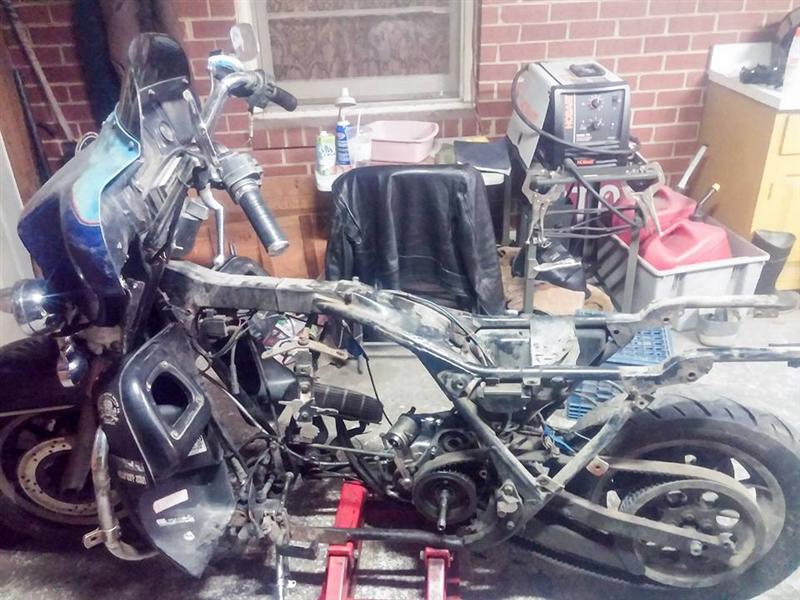
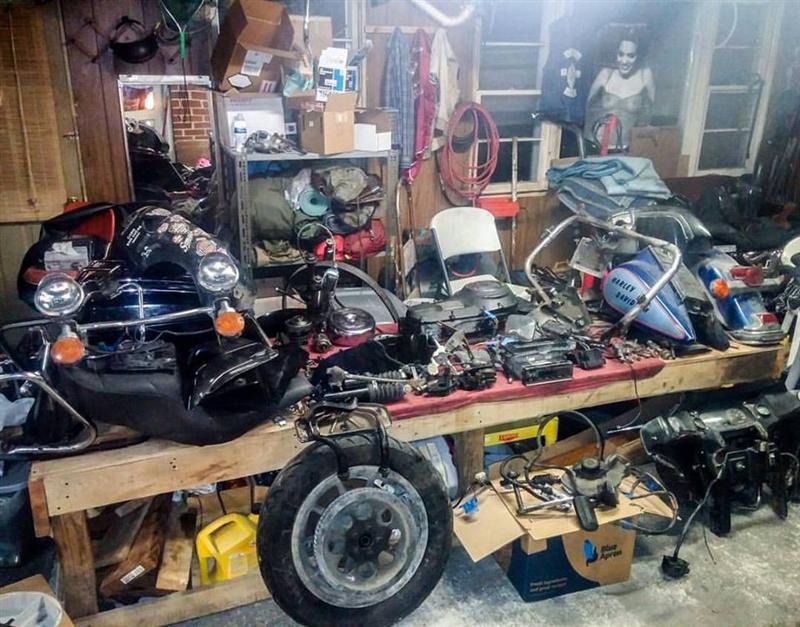
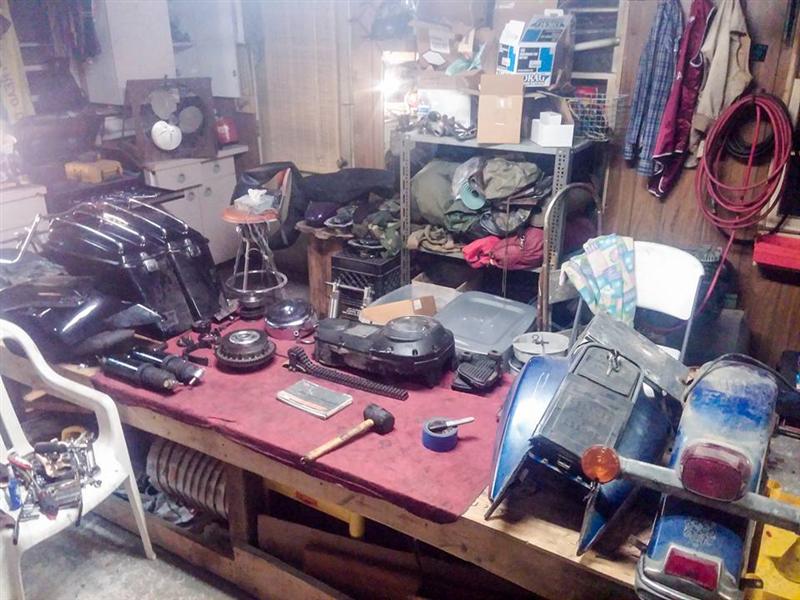
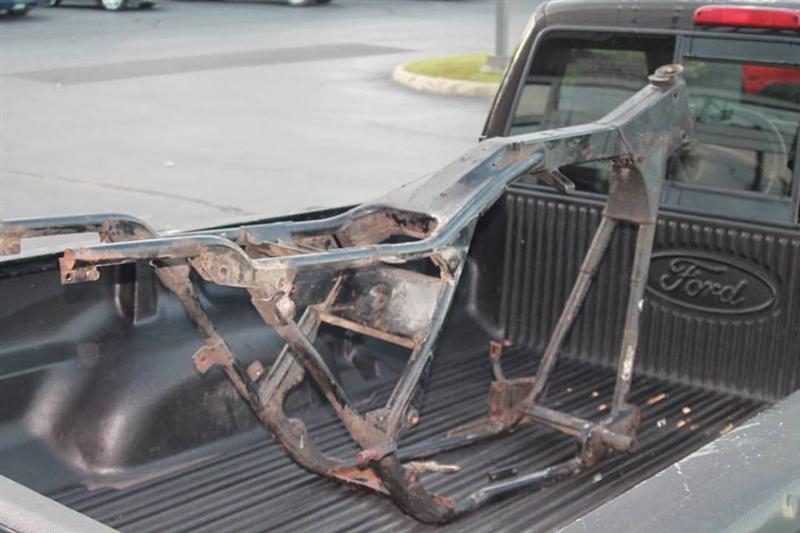
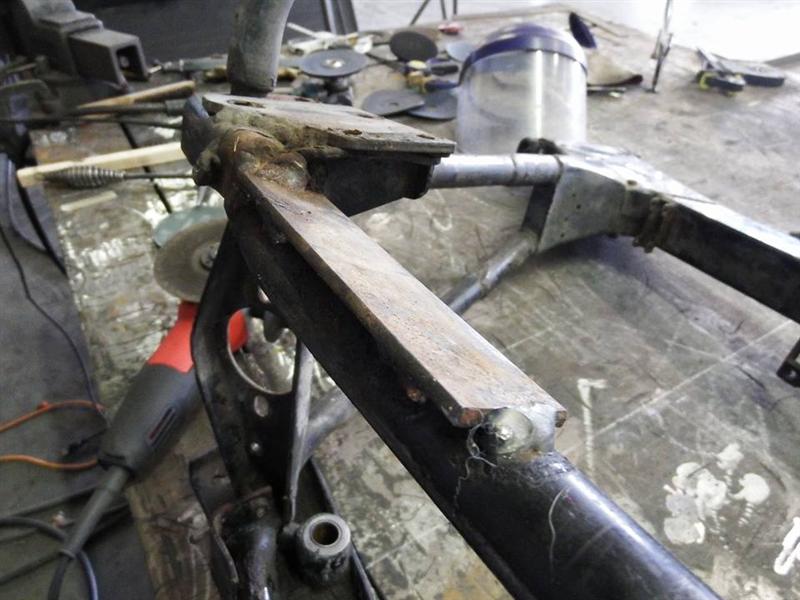
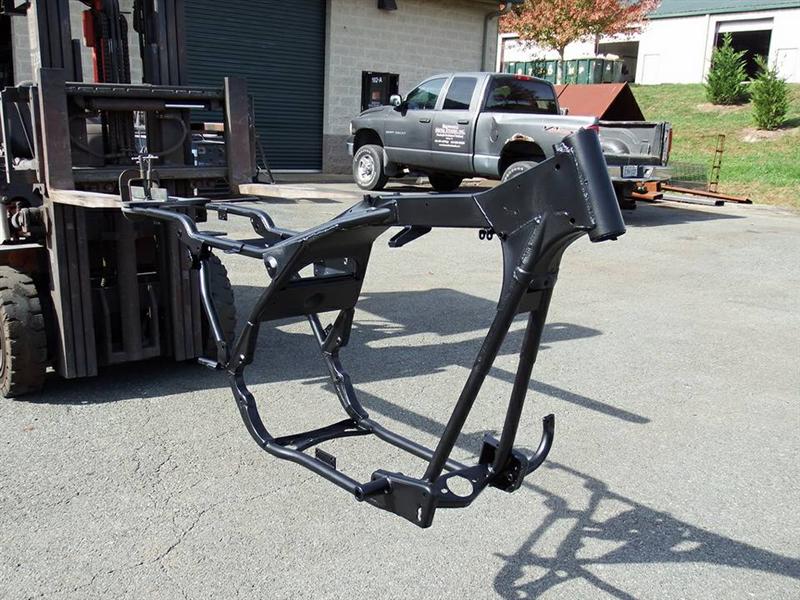
Ahuge expression of gratitude goes out to my friend Steve Brownell forselflessly donating his time and materials to bring this GypsyMachine back from the dead. As a fellow biker himself Stevereiterated to me a manta I hear and have used time and again, “That’swhat we do, brother.” With a new lease on life I closedthe tailgate behind the NEW girl, gave Steve a big appreciative hug,then drove off waving as I watched Steve and the crew in the rearview sending us on our way to future adventures yet to come.
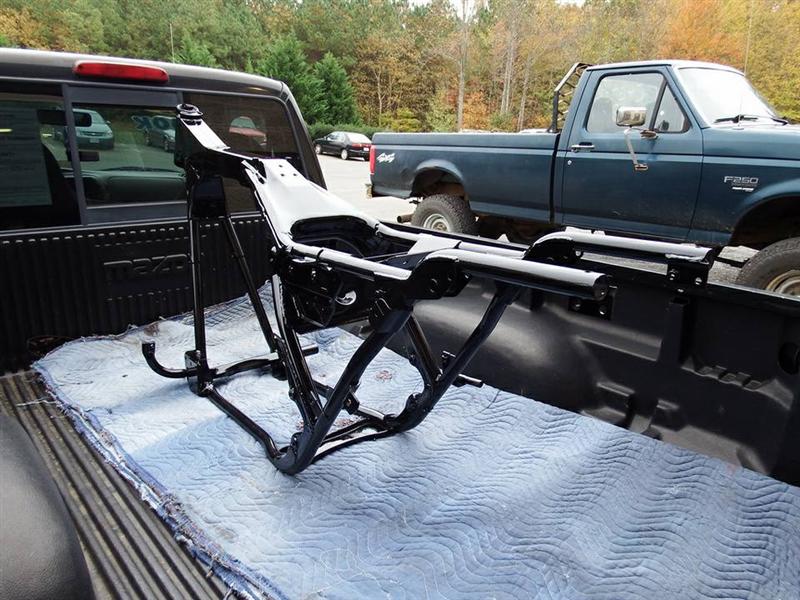
Build A Better Sportster With Café Custom Accessories From Harley-Davidson
By Bandit |






First Ride: 2017 Indian Motorcycle Chieftain Limited and Chieftain Elite
By Bandit |

 During the 2013 Sturgis Rally, the entire biker world bore witness to the return of Indian Motorcycle as a bona fide American motorcycle manufacturer. This was a huge deal as the Polaris-owned company hit both the highway and the competition pretty hard with no less than three models: the Chief Classic, the Chief Vintage, and the Chieftain. Since then, the rejuvenated Indian Motorcycle company has been busy broadening its product line with a number of variations off of its established core models. A new model line was even introduced with the nimble Indian Scout series (such a fun bike, by the way).
During the 2013 Sturgis Rally, the entire biker world bore witness to the return of Indian Motorcycle as a bona fide American motorcycle manufacturer. This was a huge deal as the Polaris-owned company hit both the highway and the competition pretty hard with no less than three models: the Chief Classic, the Chief Vintage, and the Chieftain. Since then, the rejuvenated Indian Motorcycle company has been busy broadening its product line with a number of variations off of its established core models. A new model line was even introduced with the nimble Indian Scout series (such a fun bike, by the way). 
 The two new Chieftains boast a host of refined features, sleek lines, bold styling, and loads of accessories. These bikes are real attention-getters, whether it’s the Chieftain Limited in its Thunder Black livery, or the Chieftain Elite with its unique marbled graphics over a rich, Fireglow red candy custom paint.
The two new Chieftains boast a host of refined features, sleek lines, bold styling, and loads of accessories. These bikes are real attention-getters, whether it’s the Chieftain Limited in its Thunder Black livery, or the Chieftain Elite with its unique marbled graphics over a rich, Fireglow red candy custom paint. To take the Chieftain platform to new levels of refinement, Indian Motorcycle used contrast-cut 10-spoke 19-inch front wheels. They are showcased by a cut-down, hugging front fender that breaks away with Indian’s iconic valanced fender silouhette. The tricked out 19-inch front wheels are complimented by a pair of massive floating brake rotors and 4-piston calipers with Indian Motorcycle script logo. Out back, the same wheel styles is used with 16-inch rims featuring a single brake rotor and 2-piston caliper. A color matched headlight bezel and streamlined leather saddle complete the more sleek, aggressive look. Color matching the expansive chromed bezel to the rest of the bike on the new Chieftains is a welcome fix to what some felt was a design faux-pas on the original model.
To take the Chieftain platform to new levels of refinement, Indian Motorcycle used contrast-cut 10-spoke 19-inch front wheels. They are showcased by a cut-down, hugging front fender that breaks away with Indian’s iconic valanced fender silouhette. The tricked out 19-inch front wheels are complimented by a pair of massive floating brake rotors and 4-piston calipers with Indian Motorcycle script logo. Out back, the same wheel styles is used with 16-inch rims featuring a single brake rotor and 2-piston caliper. A color matched headlight bezel and streamlined leather saddle complete the more sleek, aggressive look. Color matching the expansive chromed bezel to the rest of the bike on the new Chieftains is a welcome fix to what some felt was a design faux-pas on the original model.
 Both bikes come with Indian Motorcycle’s Ride Command seven-inch infotainment system and powerful Thunderstroke 111 engine with 119 ft-lbs of torque. Additional features include key-less ignition, remote locking saddlebags, anti-lock brakes (ABS), chrome front highway bars, power adjustable windshields, and tasteful touches of chrome here and there. The Thunder Black color treatment on the Chieftain Limited is our favorite, with its classy and subdued finish. The Chieftain Limited has an MSRP of $24,499.
Both bikes come with Indian Motorcycle’s Ride Command seven-inch infotainment system and powerful Thunderstroke 111 engine with 119 ft-lbs of torque. Additional features include key-less ignition, remote locking saddlebags, anti-lock brakes (ABS), chrome front highway bars, power adjustable windshields, and tasteful touches of chrome here and there. The Thunder Black color treatment on the Chieftain Limited is our favorite, with its classy and subdued finish. The Chieftain Limited has an MSRP of $24,499. I spent a day with fellow motojournalists riding both the Chieftain Limited and the Chieftain Elite. Our group encountered a massive rain storm that forced us at times to ride in poor visibility, but I was grateful to have a new Bell full-face helmet for the ride. As a side note, famous pinstriping artist Scratch was on hand to customize every helmet. Make sure you check his work out on social media. Before heading out to ride I always treat my face shield with Rain X, and I used one of these anti-fog cloths to keep the plastic from fogging up from the inside. Keep that in mind if that’s not something you’re already doing.
I spent a day with fellow motojournalists riding both the Chieftain Limited and the Chieftain Elite. Our group encountered a massive rain storm that forced us at times to ride in poor visibility, but I was grateful to have a new Bell full-face helmet for the ride. As a side note, famous pinstriping artist Scratch was on hand to customize every helmet. Make sure you check his work out on social media. Before heading out to ride I always treat my face shield with Rain X, and I used one of these anti-fog cloths to keep the plastic from fogging up from the inside. Keep that in mind if that’s not something you’re already doing. 


With the 2017 Chieftain Limited and Chieftain Elite, Indian Motorcycle keeps bringing exciting variations to its core models. And with more and more late-model Indians seen on the road, the American manufacturer is now flexing considerable muscle, further establishing itself as a major player in the field of heavyweight cruisers. Folks, look forward to more new stuff coming up in the future. Indian Motorcycle is clearly on a roll! —Ben Lamboeuf
2017 Chieftain Limited Specs

2017 Chieftain Elite Specs


Fork Oils the SPECTRO Variety
By Bandit |

We are rolling into a series of articles regarding oil and lubricants using the Spectro experts as our library of data. I’m beginning to find out a great deal about the quality of lubricants, during just a couple of conversations.
A lot of what you see on the market is smoke and mirrors. In some cases you need to use pricing as a grade. For instance some supposedly synthetics are Group three oils, which are petroleum based, but just the best grade. Group one is your very basic oils, Group 2 are refined and Group three are more refined.
The molecular structure of PAO lubricants or synthetics is smooth, pure, oxidation stable, high viscosity and won’t sheer. The more refined the more expensive, so if you see a synthetic label and it’s six bucks, you’re not getting the good shit, but we will study this more as we roam through the oil library.

“If you don’t change your oil every 2-3000 miles,” John Dunn said from Spectro, “You’re wasting your money on good oil.” No matter how high the quality of lube, you need to change it on regular intervals or more often depending on the use. “Engines love cross country runs. They like to get to operating temperature and stay there.”

We’re kicking off with Spectro Fork oils. Basically the various grades of Spectro suspension oil vary in weight and additive packages. With James Conway’s Dyna we plan a series of seat-of-the-pants comparisons in the very near future. There’s a lot to learn coming up. “I switched out a Ceriani glide for my Indian girder,” Go, from Brat Style mentioned after he rode his ’39 Indian 45 at the Willow Springs flat track races. “The handling was night and day.”
Let’s see how much oil grades and weights change handling on street bikes. Hang On.

SPECTRO FORK OIL
Spectro fork fluids are designed specifically for both conventional and inverted cartridge forks. Blended high V.I. base oils combined with anti-foaming additives and an anti-wear additive system fight fade and wear due to both heat and aeration. “Zero stiction” additive package and anti-foaming system for use in Kayaba, Showa and Marzocchi forks.
Description
Fork Oil: Spectro fork fluids are designed specifically for both conventional and inverted cartridge forks. Blended high V.I. base oils combined with anti-foaming additives and an anti-wear additive system fight fade and wear due to both heat and aeration.
“Zero stiction” additive
package and anti-foaming system for use in Kayaba, Showa and Marzocchi
forks.
Application
Fork Oils should be used according to the manufacturer’s recommended change intervals, fill levels and viscosity.
• PROVIDES SMOOTH, CONSISTENT DAMPING.
• PREVENTS CORROSION AND LEAKING.
• PRESERVES AND CONDITIONS FRONT FORK SEALS.
• ANTI-FOAM ADDITIVES PREVENT FOAMING AND
AERATION.
10W
15W
20W

Spectro Heavy Duty Fork Oil
Delivers superior damping and long-lasting lubrication as well as anti-foaming, anti-rust, and anti-corrosion attributes. Provides exceptional temperature stability, minimizes fluid leakage, resists fading. It also preserves and conditions your fork seals. Heavy variant limits front end dive during braking
Description
Heavy Duty fork oils were developed to meet the critical demands of today’s Harley suspension systems. They virtually eliminate fade and foaming due to thinning and air entrapment.
They exhibit temperature stability characteristics equal to or better than those of the OEM fluids they are designed to replace.
Heavy Duty fork oils contain an additive package that assures outstanding rust and corrosion resistance and were protection.
Application
Heavy Duty Fork Oils should be used according to the manufacturer’s recommended change intervals, fill levels and viscosity.
E type: 20 weight
Heavy: 40 weight

GOLDEN CARTRIDGE FORK OIL
Spectro Cartridge fluids are formulated specifically for service in modern inverted cartridge style forks. A semi-synthetic blend of the world’s leading base stocks, as well as anti-foaming and anti-wear additives, “Golden Cartridge Fork” provides zero stiction, conditions seals, and provides smoother operation. Designed for use in Kayaba, Showa and Marzocchi forks.
Description
Spectro Golden Cartridge fluids are the ultimate fork oils, formulated specifically for use in modern inverted cartridge-style forks.
They incorporate a blend of the world’s leading synthetic base oils and superior-quality petroleum base oils combined with anti-foaming additives and an anti-wear additive system that will fight fade and wear due to heat and aeration.
Application
Spectro Golden Cartridge Fork Fluids should be used according to the manufacturer’s recommended change intervals, fill level and viscosity.
Otherwise, use the 125/150 or 7.5 weight
For Racing Use
Golden Spectro Cartiridge Fork Fluids are designed to replace the OEM oils and should be changed at the Manufacturers’ recommended frequency.
• “ZERO STRICTION” ADDITIVE TREATMENT
• “ANTI-FOAMING” ADDITIVES
• PRESERVES AND CONDITIONS SEALS.
• PROVIDES SMOOTHER OPERATION.
• FOR USE IN KAYABA, SHOWA, AND
MARZOCCI FORKS.
• “VERY LIGHT” AND “LIGHT”
125/150 7.5 weight
Lakefront Noise Bill Passes Illinois House
By Bandit |

By Steven Dahlman
13-Apr-17 – The City of Chicago will install equipment to listen for noisy motorcycles along Lake Shore Drive if a bill approved by the Illinois House of Representatives is passed by the Senate.
HB2361 would allow the city to install a noise monitoring system, like one at O’Hare International Airport, to analyze vehicle noise 24 hours a day along Lake Shore Drive.

“High-rise dwellers along Lake Shore Drive share complaints on a regular basis with their elected officials about vehicular noise,” says State Representative Sara Feigenholtz (left), who introduced the bill on February 3. “This is the first step to mitigate the problem of noise pollution along the drive and provide residents with some much-needed relief.”
The system would collect data to help engineers understand the noise implications of any changes they make to Lake Shore Drive. A report, prepared one year after installation, would be made available to the public.

“Almost all the motorcycles you hear have had their exhaust system deliberately tampered with,” says 2nd Ward Alderman Brian Hopkins (right). “In some cases, they’ve removed the muffler completely. During the summer months, packs of up to 20 or more motorcycles literally rattle the windows of some of the Lake Shore Drive high-rises at two, three, four in the morning.”
The city and state are working to expand motor vehicle laws to increase fines and allow Chicago police to impound a motorcycle after the third noise violation. In addition to paying a fine, the owner would have to go to court to show the motorcycle’s muffler is compliant with the law.
The bill was passed 85-30 in the House on April 5 and referred to committee in the Illinois Senate on April 6.

(Above) Chicago Fire Department’s Ambulance 42 on Wacker Drive.
Aldermen concerned about siren noise, too
Hopkins says he plans to introduce a city ordinance that would crack down on noisy emergency vehicles. The problem is not so much with Chicago Fire Department and Chicago Police Department vehicles but with private ambulances, according to 42nd Ward Alderman Brendan Reilly.
“I’m told that private ambulance services roll the sirens non-stop for liability and insurance purposes and I’ve tried to talk to them,” says Reilly. “They basically say, sorry, it’s state law and you can’t touch us.”

(Left) Alderman Reilly speaks to a meeting of Streeterville Organization of Active Residents. At right are 18th police district commander Paul Bauer and Peter Lemmon, senior transportation engineer with Kimley-Horn & Associates.
While state law requires the siren of an emergency vehicle to measure 100 decibels from 50 feet away, about as loud as a lawn mower or motorcycle, Reilly says the city’s police and fire departments rarely run their sirens indiscriminately, preferring lights and short horn blasts.
“If they’re jamming through rush hour traffic, you’re going to hear those sirens blaring. If you’re in the back of that ambulance, you want that. But later in the evening, or the morning or mid-morning when there isn’t as much traffic going on downtown, you’ll see them use the lights and short honks going through these intersections.”
Skyline/Inside Publications assisted with this story.
A Successful Lobby Day
By Bandit |

Another legacy of ABATE is the development of a proficient grass-roots lobby effort. ABATE has always lobbied its state legislators for justice and safety, but those humble beginnings of four to five leather-clad riders meeting a dozen or so lawmakers every other year has evolved into a well-oiled machine bringing approximately 500 members and friends to the capitol each year. From the outside looking in, it appears to run flawlessly and effortlessly. In truth, months of preparation go into each year’s annual lobby day. Members, expert in presenting ABATE’s concerns, plan, coordinate, educate and facilitate each effort to meet with all 99 members of the Assembly and all 33 members of the Senate. Leadership of both political parties are also contacted as well as the governor’s office prior to the convergence on the capitol by the members of ABATE’s eight districts and 39 regions.
ABATE legislative chairperson Steve Panten had meetings with the governor’s office regarding the concern over autocycles being classified as motorcycles. He also met with Supreme Court Justice Annette Ziegler to explain some discrepancies in the definition of certain right-of-way violations.
ABATE’s lobby day was set for February 23, 2017, and in December 2016 and January 2017, Steve Panten and Executive Director Dave “Chubby” Charlebois traveled to each of the eight ABATE districts in the state to conduct workshops for members on how to properly lobby state lawmakers.
In the separate regions, certain members volunteered to set appointments for their region’s respective legislators, booking conference rooms at the capitol for afternoon meetings. To facilitate the huge number of people attending lobby day, buses were chartered throughout the state for free rides to and from the capitol, picking up riders at selected sites along the interstate system. Hupy and Abraham, S.C. has furnished these buses for the southeastern districts for several years at no cost to ABATE. Members who decided to ride or drive to Madison could park at the CC Riders MC clubhouse, a local motorcycle club influential in biker’s rights since the helmet repeal days. From there, the club furnished a free shuttle service to and from the capitol.
Once at the capitol, everyone congregated at a hotel on the square, the Best Western Inn on the Park, where ABATE provided a staging area in a conference room with coffee and doughnuts, printed materials, speaking points and group meeting designations.
Some legislators were contacted directly that day at their personal offices in the capitol. Others participated in group sessions held in conference rooms, with discussion led by two or three selected representatives of ABATE, while others in attendance listened to the commentary and any questions from the legislators or staff persons.
Although a lot of work and preparation went into the day, there was a fun element, besides the fun of participating in the legislative process. At noon, many of the ABATE members gathered for a group photo on the steps leading into the capitol building.
After meetings had concluded, participants returned to the hotel staging area to fill out completion notes and write thank you notes to be sent to legislators.
After a long day, members and friends retreated to area parking structures, hopped on chartered buses or took the CC Riders shuttle back to their clubhouse for some socializing before returning to wherever their home was. It all looked so easy and organized because it was. But looks can be deceiving. Months of work by dedicated individuals made lobby day an enjoyable experience for those who just chose to come and represent. But each of those members and friends played a vital part in making this year’s lobby day another successful event.
Vintage Rally 2017 and New Museum Exhibits
By Bandit |

Headlining the Vintage Rally is a big vintage motorcycle and bicycle show for all machines through 1988 with a special class for any form of dirt bike or two-wheel off-road machine. As before, any customs, choppers and bobbers through 2017 have a special class. Did I mention a motorcycle swap meet takes place as well? It’s all there, but you need to get to the National Motorcycle Museum that Saturday, June 10 for all these special activities.
The new DIRT RIDING USA exhibit presented by J&P Cycles will hold about 35 select motocross, trials, enduro and cross country motorcycles, a desert sled or two. In the case of bikes with a rider history, visitors get the story on the bikes and the people, the places and times, and there is apparel and off-road poster art to round out the show. This new exhibit, not open to visitors until late May, will bring total motorcycles on display in the Museum to around 475!
BARN FIND is a new permanent display at the Museum also opening in late May. Staff located salvaged barn lumber, will construct the corner of a barn in the Museum. They brought in the rusty, dusty and crusty motorcycles and parts you might find if you got lucky in your explorations about anywhere in rural America.
Attend the Vintage Rally Motorcycle Collecting panel discussion in which six experts who collect, buy and sell old bikes share their wisdom, even past mistakes and help you make smart decisions for what you surround yourself with and keep into the future. Motorcycle collecting, restoring and stewardship is bigger than ever. But as with many pursuits, there are potential pitfalls. Attend this session and you’ll get pointers on how to avoid them.
Polish up a couple of your best 1988 and older motorcycles or bicycles and bring them to the Vintage Rally Bike Show; you make the show. Arranged on the concrete show range by country of origin, judges will carefully review all entries and make their choices; about 40 trophies, sponsored by Motorcycle Classics magazine, will be awarded. Preserved/unrestored motorcycles will be judged for the Hagerty Motorcycle Insurance Preservation Award. For 2017 we are celebrating the opening of the DIRT RIDING USA exhibit presented by J&P Cycles, so all dirt bikes through 1988 are welcome. Here’s all you need to know to enter your bike.

A correctly restored first year Honda CR250M Elsinore will be among bikes loaned for the DIRT RIDING USA exhibit coming in late May, 2017.

This 1971 Bultaco El Montadero will be among enduro competition bikes in the DIRT RIDING USA exhibit.

BARN FIND, a new exhibit opening in late May 2017 reminds us of all the cool motorcycle stuff that may be lurking in barns all across America.

With the entire Changing Exhibitions gallery set aside for the DIRT RIDING USA exhibit, these and a couple of dozen other Enduro, Trials and Motocross bikes will have a proper display area.
Harley-Davidson Rejects Military Wife’s Late Check
By Bandit |

.jpg)
Jaime sent in a check with her husband’s payment along with an apology note explaining why she was turning in the payment late. When Dennis saw Jaime’s note, he refused to accept her money.
“You send that money back to her!” he told his office employee. “I never, ever!”
It turns out, many years ago– during the Vietnam War– Dennis was nearly drafted but was discharged due to a medical problem. Since then, he’s been extra aware of the sacrifices made by our armed forces, and he’s always been looking for ways to give back.
That’s why accepting Jaime’s money was not only a problem for Dennis personally, but it was against a policy Dennis has upheld throughout his 18 years of ownership.
Dennis wrote back to Jaime, returning her money and explaining his dealership’s policy, then he went about his business thinking nothing of it.

Dennis doesn’t even use Facebook and never expected all of this notoriety. But the attention didn’t just shock him, it moved him and restored his faith in America.
“It was impossible to answer them all. I got to thinking, this is America and people DO care. They care about their soldiers and they’re expressing that.”
“America is still America. I was a little worried about how our country was going, and to see people step forward in this way, it’s just enlightened me,” said Dennis. “A small effort like this, and look where it’s gone. Maybe more will do the same thing.”

